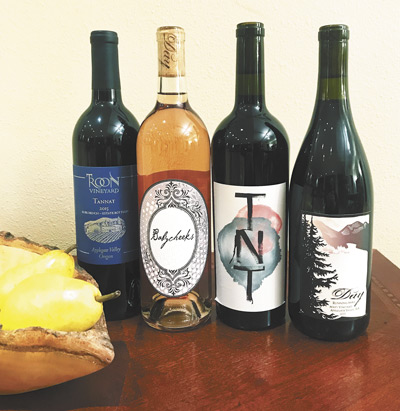Tannat or Not Tannat
Where to find the rich, tannic, unusual grapes is the question
Oh, Oregon, you and your ever-tempting plethora of grapes. Between variations in climate, soil and geography and the experimental nature of the state’s winegrowers and winemakers, finding interesting Oregon wines is never a problem. Such is the case for Tannat.

Tannat, originally from southwestern France, ranks as the national grape of Uruguay — planted by Basque farmers in the 1800s — and is gaining popularity in Oregon. Traditionally used as a blending grape, Tannat is not only known, and named, for its high tannins — the Latin root is tannare, after all — but also for its thick skins, high acid and dark, inky color.
According to Brianne Day of Day Wines, Tannat behaves much differently in Oregon from other places. “It isn't crazy, over-the-top tannic, and it doesn't get big, ripe and chewy,” she explains. “Perhaps because our climate only allows for it to get just ripe enough, and not overly ripe, it stays fairly elegant, and the acid is always extremely present.”
Herb Quady of Quady North — and former winemaker for Troon Vineyard — recalls grafting some of Troon’s Chardonnay acreage over to Tannat in 2006. He explains the grapes were typically harvested late and at high acid. Troon made a stand-alone Tannat until Quady was tasked with making a Tannat and Malbec side by side. He says, “The Tannat needed de-acidulation and the Malbec would have to be acidulated — which seemed ridiculous — so instead, I decided to blend them at crush. This later became the MT, which turned out to be delicious.” Troon now calls this wine Cuvée Pyrénées, named for the mountain range that defines this winemaking region.
In 2009, Quady planted Tannat and Malbec in his own vineyard thinking they would be a future source. He says, “I didn’t really have a plan for them, but Brianne thought it would be fun to pick them as a field blend, alongside the Cabernet Franc that was adjoining it, which became the source for Day Wines’ Running Bare.”
Day now uses Tannat for blended and stand-alone wines in her Running Bare, a gorgeous mélange of Tannat, Cabernet Franc and Malbec; TNT, a straight Tannat as bold as it is stunning; and Babycheeks, a super sexy rosé of Tannat and Malbec.
Craig Camp, Troon’s general manager, describes the estate Tannat as a statement about pure Tannat; it’s their biggest, richest wine. Camp says, “While by California standards, it’s not exactly a ‘big’ wine, by Oregon standards, it is, and its structure gives strong testament to the diversity of Oregon's winegrowing regions.”
Tannat, though rich, expressive and interesting all on its own, is clearly striking in blends. Troon’s estate Tannat and Malbec make ideal companions. The structured Tannat melds with the generous Malbec, creating unique textures and exotic aromatics. Co-fermentation is key. Camp says, “Combining the two varieties in the same fermenters slightly changes the chemistry of the fermentations. The two varieties become totally integrated, almost like creating a whole new variety. You could never achieve this completely entwined character with simple blending after the fact.”
Troon may have discovered the secret to taming the robust grape, producing wines with a firm and tannic structure but without a hint of green or bitter notes. The natural silkiness of the grape allows them to eschew the use of new oak barrels. Camp says laying the tannins from new oak barrels over the grape’s already naturally generous tannic structure would be ... well, just stupid. He claims, “All it would do is bury the character of our vineyard, which we are working so hard to fully express.”
Other Oregon wineries in hot pursuit of Tannat include Teutonic Winery, which previously produced the region’s only white Tannat. When asked why the brand is no longer making it, co-owner Olga Tuttle says, “We just can’t get any more fruit. If we could, we would. It's in high demand. I have tried, believe me. Every year, same story. I'm very bummed about it.” Having enjoyed her white Tannat, I can say, “So am I.”
Byron Dooley of Seven of Hearts struck Tannat gold with grapes from the Oregon side of the Columbia Valley. He made three vintages of Tannat, 2012–2014, that were extremely popular and well received. So much so, the 2013 vintage was named the No. 4 best wine of 2016 in The Seattle Times and was also on Portland Monthly’s Top 50 wines list. Unfortunately, the small block he sourced fruit from was destroyed after the 2014 harvest in a freak weather event and he hasn’t made this wine since. Thankfully, he does have plans to try to source it again next year. Fingers crossed.
Fortunately, for Andrew Beckham of Beckham Estate Vineyard, he’s landed a small lot of Tannat. “We purchased the fruit from a vineyard in the Columbia Gorge. The owner grafted a small section to Tannat, among other varietals, to see how it performed. Thus far, we are really pleased with the balance and expression of this fruit.” Beckham continues, “It is a varietal I’ve been eager to work with.”
Some theorize the granite-rich soils in Southern Oregon naturally generate wines with softer tannic structure than those from France. Camp says, “I really believe this is a great variety for the Applegate Valley, as our climate and granitic soils round out its famous tannins.”
Growers certainly haven’t had much trouble ripening it lately. Late-budding, hardy and resistant to frost, it is drought-tolerant and sets huge clusters. So, as Oregon’s weather evolves, and we ask Tannat or not Tannat? The answer is, definitely, Tannat.


 Tamara Belgard is a freelance writer who explores the Oregon wine scene from her home in S.W. Portland.
Tamara Belgard is a freelance writer who explores the Oregon wine scene from her home in S.W. Portland.









